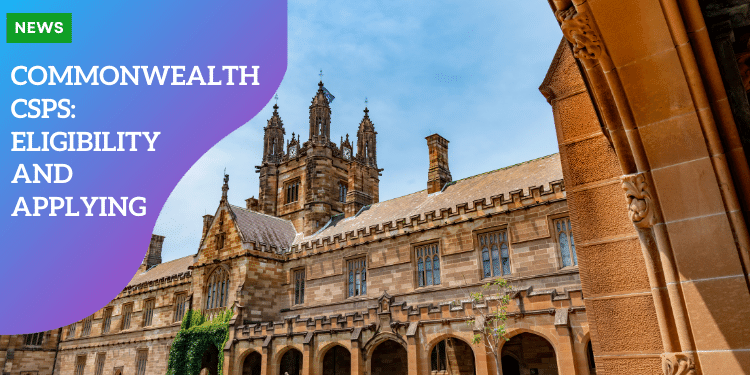Commonwealth CSPs: Eligibility and Applying

Government Subsidy and Student Contribution Amount
The CSP program is a boon for students, but it’s crucial to understand that it doesn’t foot the entire bill.
While the government subsidy takes care of a chunk of the fees, there remains a ‘student contribution amount’ that you, as the student, are responsible for.
✅This amount varies depending on the course and the institution but is generally much lower than what you’d pay as a full-fee-paying student.
Eligibility Criteria for Accessing CSPs
Embarking on the quest for affordable education through a Commonwealth Supported Place (CSP) is akin to unlocking a treasure chest—yet it comes with a specific combination.
Let’s meticulously examine the eligibility criteria that can pave the way to accessing these coveted educational subsidies.
Detailed Breakdown of the Eligibility Requirements for CSPs
First and foremost, CSPs are not available to everyone; they’re targeted at helping certain groups of students. To be eligible, you must:
✅Be an Australian citizen
✅New Zealand citizen
✅Or an Australian permanent visa holder.
✅You also need to be enrolled in a course of study at an approved higher education provider
✅It’s essential to check if your chosen field of study qualifies for this support.
✅Additionally, you must be planning to study at least part of your course in Australia—a key aspect since CSPs are partially funded by the Australian government and are intended to benefit domestic education.
Importance of Citizenship, Visas, and Unique Student Identifier (USI)
Citizenship or an appropriate visa is your golden ticket into the realm of CSPs.
If you’re an international student, the door to this particular funding avenue is closed. For Australian citizens, it’s necessary to be studying in Australia.
For New Zealand citizens and Australian permanent residents, you need to be residing in Australia for the duration of your study.
✅Moreover, to bring everything together under one roof, you’ll need a Unique Student Identifier (USI).
Think of the USI as your educational passport; it’s a unique number assigned to you that helps keep your study records organized and accessible across all Australian educational institutions.
Discussion on Academic Entry Requirements and Study Limitations
Let’s talk grades and caps. Even if you tick all the boxes for citizenship and residency, there’s still the matter of meeting academic entry requirements.
✅Universities and institutions typically have their own set benchmarks for courses.
These can be ATAR scores, previous work experience, or portfolio submissions, depending on what you’re aiming to study.
Also, keep in mind that there’s a limit to how much CSP supported study you can undertake. This is called the ‘Commonwealth supported place lifetime limit’ and it acts as a cap on the amount of study you can be supported for.
It’s measured in Equivalent Full-Time Study Load (EFTSL) and ensures that funding is distributed fairly among students.
✅So, plan your study path wisely to make the most out of the support available to you.
Applying for and Securing a CSP
Once you’ve navigated through the maze of eligibility criteria for Commonwealth Supported Places, the next crucial step is actively securing your spot.
But how do you ensure that your desired course has a CSP available?
This process involves a few key steps which we’ll delve into, starting with verification.
Steps to verify CSP availability in the desired course
Embarking on this journey begins with research.
Universities often list whether a course is a CSP on their website, so that’s your first port of call.
✅Check the course descriptions carefully to see if they mention CSP eligibility.
If information isn’t readily available or you’re unsure, don’t hesitate to contact the university’s admissions office for confirmation.
It’s essential to do this as early as possible since CSP spots can be limited and are often allocated on a first-come, first-served basis.
Guidance on applying through Admissions Centre or directly to the education provider
Now that you’ve confirmed CSP availability, the application process awaits.
In Australia, most applications for undergraduate courses are processed through a Tertiary Admissions Centre (TAC), such as UAC, QTAC, or VTAC, depending on the state you’re in.
Register with the relevant TAC and follow their procedures, keeping an eye on deadlines.
For postgraduate courses or if you’re applying later in the cycle, you might apply directly to the institution.
Whichever route you take, ensure that you indicate your interest in a CSP on your application form.
Instructions on accepting the CSP offer and submitting necessary documentation by deadlines
✅Your diligence pays off when you receive an offer for a CSP!
Accepting the offer is time-sensitive and usually straightforward—just follow the instructions provided by the university or TAC. This often involves logging into an online portal and formally accepting the CSP.
Additionally, you’ll need to provide supporting documents, which typically include proof of citizenship or residency, your Unique Student Identifier (USI), and academic transcripts.
✅Be meticulous with these details; missing a deadline or submitting incomplete documentation could mean losing your CSP to another candidate.
Remember, each step taken towards securing a Commonwealth Supported Place brings you closer to quality education at a more affordable rate.
So, keep a keen eye on the details, stick to the timelines, and soon enough, you’ll be all set to embark on your educational journey with the support of a CSP!
Strategies for Leveraging CSPs to Access Quality Education Affordably
- ✅Firstly, consider the field of study. Some courses offer more CSPs than others, reflecting areas of national skills shortage or prioritized sectors by the government. By choosing a course in one of these areas, not only do you benefit from reduced fees, but you also position yourself in a field with potential for future demand. Additionally, be proactive and apply early for CSPs since they are often limited and allocated on a first-come, first-served basis.
- ✅Secondly, take full advantage of the flexibility CSPs offer. If you’re working or have other commitments, CSPs allow you to study part-time or even defer your studies if necessary. This way, you can balance your workload with your personal life, ensuring that you don’t overextend yourself financially or mentally while pursuing higher education.
- ✅Lastly, always keep an eye on academic progress. Maintaining a good academic record is crucial as it could affect your ongoing eligibility for a CSP. Falling behind not only jeopardizes your place but could also result in additional costs if you need to repeat subjects.
Benefits of Utilizing CSPs for Undergraduate and Postgraduate Studies
CSPs are not just for undergraduates; they’re also available for some postgraduate coursework programs. The benefits of a CSP extend beyond the obvious financial savings.
- ✅For undergraduate students, it’s about making higher education accessible at the start of their academic journey.
- ✅For postgraduate students, it means being able to further specialize or change career paths without the burden of full-fee rates.
In both cases, students can enjoy the same high-quality teaching, resources, and support as full-fee paying students, ensuring that the quality of education remains uncompromised.
Moreover, a CSP can open doors to networking opportunities and experiences that may otherwise have been out of reach due to cost constraints.
Tips for Students to Make Informed Decisions Regarding CSPs and Course Selection
When selecting a course under a CSP, look at the long-term outcomes. Research the career pathways that your chosen course will enable and compare them against industry trends.
- ✅It’s important to select a course that not only interests you but also has the potential to lead to sustainable employment.
- ✅Don’t forget to factor in the location of the university and the living costs associated with studying there. Sometimes the savings made on tuition fees can be offset by high living expenses if you’re not careful.
- ✅Also, consider the reputation of the institution and the course’s alignment with your career goals. A well-regarded program may offer better internship and employment prospects upon graduation.
- ✅Finally, engage with academic advisors and career counselors provided by the university. They can offer tailored advice based on your interests and circumstances, helping you to chart a course that maximizes the benefits of your CSP.
Keep communication lines open with the university’s financial aid office too, as they can inform you of any additional scholarships or bursaries for which you may be eligible.By approaching your CSP and course selection with strategic thought, you can ensure that you not only save money but also invest wisely in your future.
✅Higher education is a significant stepping stone to professional success, and with a CSP, it’s one that can be reached with less financial stress.
PROVIDERS OF CSPs





